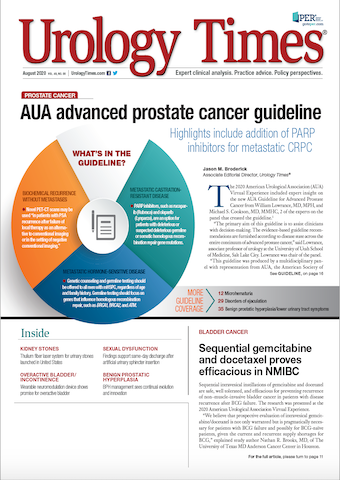Publication
Article
Urology Times Journal
Cancer-related pain indicative of poor prognosis for metastatic CSPC
Author(s):
Investigators found that while patients without pain had an overall survival of 56 months, patients with pain had an overall survival of only 27 months.
Cancer-related pain is indicative of a poor prognosis in metastatic castration-sensitive prostate cancer (mCSPC) patients, according to a paper published in Prostate Cancer and Prostatic Diseases.1
Some distinguish mCSPC prognostic classes based on disease burden and other clinical features. Researchers have used the presence of visceral metastasis, extent of bone metastasis, and Gleason score to classify these patients prognostically.
However, without direct comparisons among therapeutic options and given the absence of a reliable molecular and clinical prognostic stratification of mCSPC, it’s difficult to optimally select treatment, according to the study results.
“Being able to distinguish different prognostic ‘classes’ of mCSPC so as to tailor the treatment for each patient is one of the greatest future challenges,” the investigators wrote.
A group of French researchers analyzed data from about 370 de novo metastatic patients. Pain data were included for 365 of those patients, and pain was present in about a third (34.8%) of cases. According to the paper, pain was associated primarily with high value of prostate-specific antigen, greater bone extension of disease, and lymph node involvement. Pain was not associated with visceral metastases.
They found that while patients without pain had an overall survival of 56 months, patients with pain had an overall survival of only 27 months. Patients with pain in the study also had significantly lower progression-free survival at 10.1 months, versus 17.4 months among patients who did not report cancer-related pain.
When it does metastasize, prostate cancer most often spreads to bone, which often results in debilitating pain and limited function. Many associate cancer-related pain to be a key prognostic indicator that men with castration-resistant prostate cancer have a poorer prognosis than patients without pain.
But more work is needed to determine cancer pain’s true prognostic value in mCSPC.
“External prospective validation of CSPC patient cohorts is required to establish if cancer-related pain can help in guiding the treatment decision process,” the investigators concluded.
2 takeaways for clinicians
Urologists should consider 2 important takeaway points from this paper, according to urologist and urologic oncologist Christopher Filson, MD, MS, assistant professor of urology at Emory University School of Medicine in Atlanta, Georgia.
“One is understanding the importance of being thorough and assessing the degree of pain that an advanced cancer patient may be experiencing,” Filson said. “The second point is ensuring that, should a patient develop pain, not only is it a sign that it may be more advanced disease from a prognostic standpoint, but also that the issue of pain should be addressed.”
It’s becoming increasingly clear that palliative care is critical for patients who have advanced cancer, according to Filson, who was not involved with the research.
“There’s a presumption that palliative care is reserved for patients who have end-of-life issues or are within the last 30 days of their lives. But the data suggest that palliative care has a role for any patient with advanced cancer who may be experiencing symptoms like pain,” he said. “For me, reading the article reinforced my belief that, first of all, assessing patients’ cancer pain is critical, and should there be pain present, to consider addressing their needs with palliative care whether they have weeks, months, or even years to live.”
Reference
1. Iacovelli R, Ciccarese C, Caffo O, et al. The prognostic value of pain in castration-sensitive prostate cancer. Prostate Cancer Prostatic Dis. Published online July 10, 2020. https://doi.org/10.1038/s41391-020-0255-x


























Stent omission after ureteroscopy is safe, improves patient-reported outcomes
Intervention to increase fluid intake does not reduce recurrent stones
Physical function and frailty measures offer distinct insights in patients with bladder cancer
FDA to host advisory committee meeting on UGN-102 for NMIBC
2 Commerce Drive
Cranbury, NJ 08512
All rights reserved.







